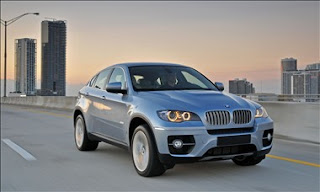BMW X6 ActiveHybrid Review
 2010 BMW X6 ActiveHybrid — First Drive Review
2010 BMW X6 ActiveHybrid — First Drive ReviewAlthough BMW initially shunned hybrids in favor of clean diesels and other alternative powertrains, the German automaker is joining the electrically assisted fray next year with not one but two gasoline-electric vehicles: the 2010 BMW ActiveHybrid 7 — our first drive of which you can read here — and the 2010 BMW ActiveHybrid X6.
Both models share ActiveHybrid badging and fall in the contradictory performance-hybrid segment, but their similarities end there. The 7 is a mild hybrid that uses an electric motor in its eight-speed automatic gearbox and a compact lithium-ion battery mounted in the trunk to assist acceleration and run the accessories; the X6 is a far more complex full hybrid. The latter's pair of motors and advanced electronic continuously variable transmission allow it to waft up to 1.6 miles and at speeds of up to 37 mph on electric current alone. Forget about Prius-like fuel economy, though, because the ActiveHybrid X6 is the most powerful hybrid yet produced, with the electric bits combining with a 400-hp, 4.4-liter twin-turbocharged V-8 to produce a total output of 480 hp and 575 lb-ft of torque. (When pressed on why it didn't choose to pair the hybrid system with the X6 xDrive35i's twin-turbo six-cylinder, BMW simply says that using the V-8 made for the largest jump in efficiency. Plus, the company added, the resulting vehicle would be slower.)
Two Modes and Lots of Explaining
Based around the two-mode CVT BMW co-developed with General Motors and the old DaimlerChrysler, the X6 hybrid is similar in concept to hybrid versions of GM's full-size SUVs and pickups, as well as the short-lived Dodge Durango and Chrysler Aspen hybrids and the upcoming Mercedes-Benz ML450 hybrid. That concept in a nutshell: Take a big vehicle with a relatively inefficient, large-displacement engine and pair it with an electrified transmission that keeps the powertrain at maximum efficiency no matter what the speed to improve city fuel economy without sacrificing highway efficiency.
Compared with the GM and Chrysler examples, which blend CVT operation with two electric motors and three planetary gearsets for a total of four fixed gear ratios, the X6's unit stirs in three additional, "virtual" ratios, effectively making the transmission a seven-speed for better dynamic performance. As with the normal X6, manumatic shifting is performed via the console shifter or wheel-mounted paddles. The two electric motors within the gearbox — rated at 91 and 86 hp and 192 and 206 lb-ft of torque, respectively — assist with high- and low-speed mobility while also helping to recapture wasted energy through regenerative braking. The juice, stored in a 2.4-kWh nickel-metal hydride battery pack under the floor of the X6's cargo hold (it lives where conventional X6 models keep their spare tires; run-flats are standard on the hybrid), is then fed back into the system and on to the drive wheels.
It Moves, Stops, and Turns
On the surface, the X6 ActiveHybrid feels much like the all-wheel-drive X6 xDrive50i on which it's based. And that's a good place to start, because although we still find the vehicle's overall design and purpose confusing, it's fast, agile, and immensely capable, despite weighing in excess of 5200 pounds. The X6 hybrid even retains the regular model's torque-vectoring rear differential, which allows for physics-defying changes in direction by actively routing power to the outside rear wheel when cornering. It might not be the most efficient package on which to base a hybrid, but the X6 is one of the sportiest platforms yet to gain the ability.
However, the preview-drive route BMW chose in and around downtown Miami offered little insight into the X6 hybrid's dynamic behavior. Cruising through the city, we noticed the engine smoothly and routinely shut off and restarted at stoplights (unless we were in sport mode or if the battery was nearly drained). Accelerating using electric-only power could be done with a fair amount of throttle, unlike in some other hybrids where the engine cuts in at even a hint of pedal movement. There occasionally was some hesitation when we quickly jumped to the accelerator and the hybrid system's electronic brain had to decide how best to direct the power to all the gears and motors, but the vehicle definitely was quick once it got moving. Despite the added 400-ish pounds of hybrid gear, BMW says the ActiveHybrid is only 0.1 second slower to 60 mph — 5.4 seconds — than the nonhybrid V-8 X6. We think a 5.2-second time is possible, given that our long-term X6 xDrive50i managed the task in 5.1. Top speed is electronically limited to 130 mph, and towing capacity is a substantial 6000 pounds.
Fuel Economy and Pricing
Unlike the 7-series hybrid's electrically assisted brakes, which we said remained firm and linear despite their regenerative capability, the X6 hybrid's felt rubbery and isolated. We eventually got used to them, but the initial lack of confidence wasn't good in something approaching three tons. The electric steering also felt light and disconnected compared with the normal model's hydraulic system.
In terms of fuel economy, the X6 hybrid has an EPA city/highway rating of 17/19 mpg; for comparison, the xDrive50i is rated at 13/18. That should mean an improvement over our long-term X6's 15-mpg average, but there's no masking the twin-turbo V-8's considerable thirst when it's called on to move the X6's bulk with any haste.
Packaging as Confusing as the Drivetrain
Visual cues are limited to a pair of small badges on the flanks and hatch and an angular hood bulge to accommodate the hybrid electronics. Unique 20-inch wheels with summer tires are standard (19s with all-season rubber are optional), and the X6 wears the optional and BMW-hybrid-only Bluewater Metallic paint well.
Inside, a power-flow meter in the main infotainment screen tells you where all the juice is going, and a small gauge in the lower part of the tach shows battery status, the amount of electric boost, and brake-energy recuperation. The four-seat layout and maximum 60 cubic feet of storage remain, as does the vision-limiting, sloping rear hatch. Overall, comfort and refinement are high, however, and the latest iteration of iDrive is actually fairly intuitive to use. Major options include ventilated seats, a rear-seat entertainment system, an upgraded sound system, and a Cold Weather package that includes a heated steering wheel and heated washer squirters.
A Token Gesture
We can't argue that the ActiveHybrid X6 is one of the best full hybrids to drive, but we nearly fell out of our chair when BMW said it will be asking $89,775 for one when it goes on sale in December. Although there's a considerable amount of standard equipment that is optional on the nonhybrid models — including nappa leather trim, keyless access, soft-close doors, a rearview camera, auto-dimming mirrors, heated front seats, four-zone climate control, a head-up display, and more — that's $12,000 more than a comparably equipped and sharper-driving xDrive50i. It's also the same base price as that of the 555-hp X6 M's.
The company claims to have no other applications in store for the two-mode drivetrain and refuses to estimate how many X6 hybrids it will sell — likely very few. Given that, we're even more perplexed as to why this vehicle exists than we are the normal X6. When asked why no weight-saving measures were taken to improve efficiency and performance — as GM did with its hybrid SUVs — BMW baffled us further by saying it was focused solely on developing the fastest, most powerful, and best-driving hybrid ever. How, we wonder, are those goals at odds with reducing weight?
Although we commend BMW's effort to embrace full-hybrid technology, and even the resulting vehicle's capability, the motives behind it seem cemented in corporate hubris. For the few folks who crave a large, immensely powerful crossover and believe they could actually help Mother Earth with such a purchase, the ActiveHybrid X6 fills the bill. For us, we'll plant a couple of trees and take the X6 M for the same money.
Performance data:
PERFORMANCE (C/D EST):
Zero to 60 mph: 5.2 sec
Standing ¼-mile: 14.0 sec
Top speed (governor limited): 130 mph
FUEL ECONOMY:
EPA city/highway driving: 17/19 mpg
source-http://autos.msn.com



Comments
Post a Comment